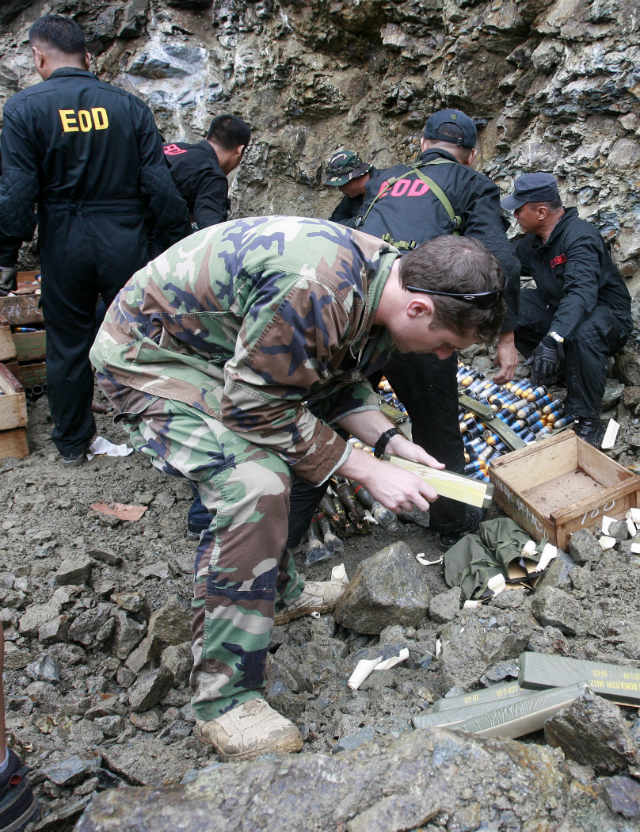SUMMARY
This is AI generated summarization, which may have errors. For context, always refer to the full article.

MANILA, Philippines – The United States on Thursday, June 26, announced it will disband its anti-terror task force in the Philippines after more than a decade, but will keep many of its functions under a special team.
In a statement, US Embassy spokesman Kurt Hoyer confirmed that the US Joint Special Operations Task Force-Philippines (JSOTF-P) “will no longer exist” after a transition plan is set.
Hoyer said the “success” of JSOTF-P has led the Special Operations Command, Pacific and JSOTF-P planners, “in coordination with our Philippine partners, to begin working on a transition plan where the JSOTF-P as a task force will no longer exist, but many of the capabilities will remain” under the Pacific Command Augmentation Team.
Hoyer explained: “Our partnership with the Philippine Security Forces has been successful in drastically reducing the capabilities of domestic and trans-national terrorist groups in the Philippines – to the point where they have largely devolved into disorganized groups resorting to criminal undertakings to sustain their activities.”
Watch this report below.
The US formed the JSOTF-P in 2002 to help the Philippine military respond to extremist threats. (READ: What is EDCA? Look at Zambo’s PH-US joint operations)
‘Reducing their numbers’
In an interview with reporters, Defense Secretary Voltaire Gazmin said the group of 500 to 600 American servicemen rotating through the strife-torn southern Philippines was cut back to 200 starting this year.
“They were never permanent. They just teach, they train our people, and they are satisfied with what we have learned so they are reducing their numbers,” he said.
Gazmin said the work of Filipino troops had improved sharply since their US counterparts, primarily special forces, started rotating through the south around 2002, adding that the Americans had also learned “jungle warfare” from the Filipinos.
Gazmin also said that American training and loans of US equipment had played a crucial role in weakening the Abu Sayyaf, a Filipino Muslim extremist group linked to the worst terror attacks in the country’s history.
This includes the bombing of a ferry in Manila in 2004 that killed more than 100 people, as well as dozens of kidnappings in the remote and Muslim-populated south, often targeting foreigners including Americans.
‘New challenges’ for Philippines
In an interview with Rappler’s Maria Ressa on June 17, US Ambassador to the Philippines Philip Goldberg said the US is reducing JSOTF-P personnel for two reasons.
First, he said, “the transnational threat is much reduced.”
Second, “the capacity of the Philippine armed forces and special forces has increased.”
“So we now believe we’re in the point that we can now turn this over to the Philippines,” Goldberg said.
The Philippine military, he added, faces “new challenges” – from “internally focused” threats in Mindanao in the past, to maritime issues, humanitarian assistance, and disaster relief at present.
Abu Sayyaf’s ‘serious setbacks’
Founded in the 1990s with seed money from Osama bin Laden’s Al-Qaeda network, the Abu Sayyaf has survived over the past decade by drawing support from poor Muslim communities that have become a fertile recruiting ground.
But it has suffered serious setbacks in recent weeks, including the arrest of one of its top leaders Khair Mundos, listed by the US government as one of its “most wanted” terrorists with a $500,000 reward on his head.
The cutback of US troops in the southern Philippines comes after Washington and Manila signed a new defense agreement in April, allowing American forces greater access to bases in its former colony. (READ: Senators pinpoint 7 flaws in EDCA)
Washington announced a “pivot” towards Asia in 2011, including a stronger military presence.
The defense pact also comes as the Philippines seeks more US help in dealing with territorial disputes with an increasingly assertive China. – with reports from Agence France-Presse/Rappler.com
Add a comment
How does this make you feel?
There are no comments yet. Add your comment to start the conversation.